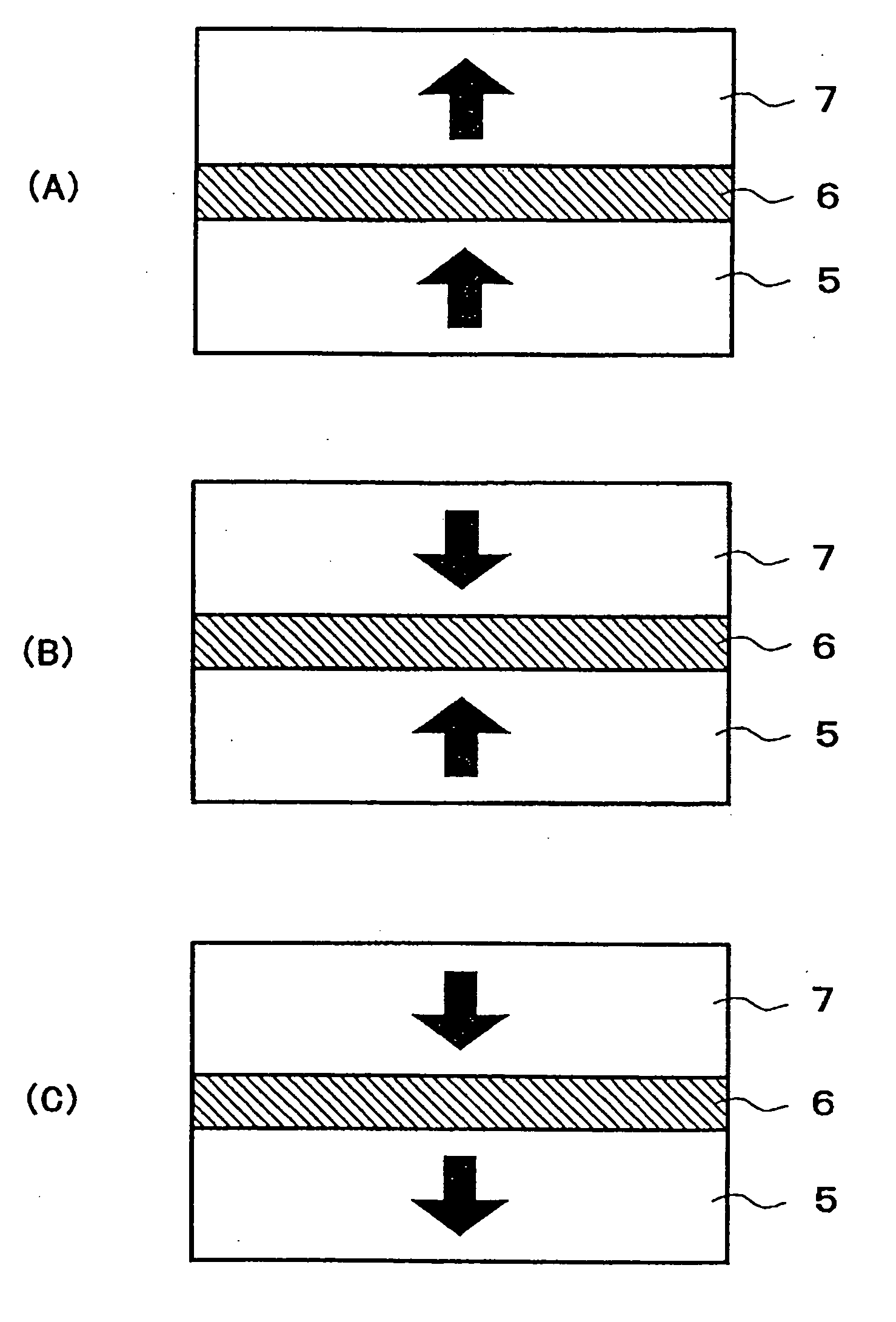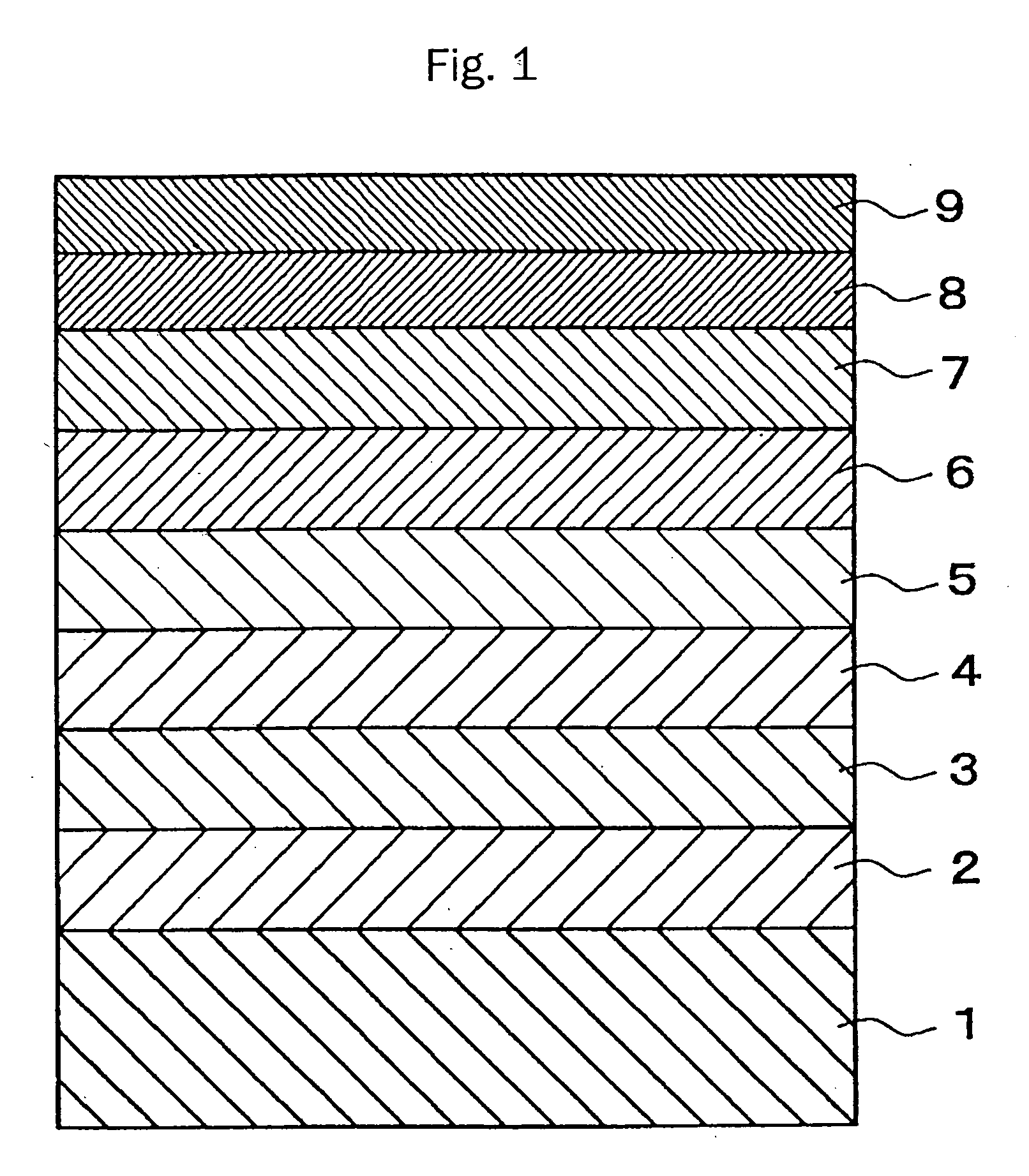Perpendicular magnetic recording medium
a magnetic recording medium and perpendicular technology, applied in the field of perpendicular magnetic recording medium, can solve the problems of more significant thermal fluctuation, failure to stabilize the retention of recorded signals, and “thermal fluctuation” has become a problem, so as to improve the performance of noise characteristic, s/n characteristic, and other characteristics
- Summary
- Abstract
- Description
- Claims
- Application Information
AI Technical Summary
Benefits of technology
Problems solved by technology
Method used
Image
Examples
example 1
[0065] An example is described on a perpendicular magnetic recording medium manufactured with a structure shown in FIG. 1. Nonmagnetic substrate 1 used was a chemically strengthened glass substrate having a smooth surface (N-5 glass substrate manufactured by HOYA Corporation). After cleaning, the substrate was introduced into a sputtering apparatus and amorphous soft magnetic backing layer 2 of CoZrNb having a thickness of 200 nm was deposited using a target of 87 at % Co-5 at % Zr-8 at % Nb. Then, underlayer 3 of NiFeSi having a thickness of 11 nm was deposited using a target of a Permalloy, 82 at % Ni-12 at % Fe-6 at % Si. Subsequently, nonmagnetic intermediate layer 4 of ruthenium having a thickness of 10 nm was deposited using a target of ruthenium under an argon gas pressure of 4.0 Pa. Subsequently, first magnetic recording layer 5 of CoCrPt—SiO2 having a granular structure and a thickness of 10 nm was deposited using a target of 90 mol % (74 at % Co-12 at % Cr-14 at % Pt)—10 m...
example 2
[0078] A perpendicular magnetic recording medium having a structure shown in FIG. 1 was produced with varied materials for the magnetic recording layers and for the coupling layer. Nonmagnetic substrate 1 was a chemically strengthened glass substrate having a smooth surface (N-5 glass substrate manufactured by HOYA Corporation). After cleaning, the substrate was introduced into a sputtering apparatus and amorphous soft magnetic backing layer 2 of CoZrNb having a thickness of 200 nm was deposited using a target of 87 at % Co-5 at % Zr-8 at % Nb. Then, underlayer 3 of NiFeSi having a thickness of 11 nm was deposited using a target of Permalloy, 82 at % Ni-12 at % Fe-6 at % Si. Subsequently, nonmagnetic intermediate layer 4 of ruthenium having a thickness of 10 nm was deposited using a target of ruthenium under argon gas pressure of 4.0 Pa. Subsequently, first magnetic recording layer 5 of CoCrPt—SiO2 having a granular structure and a thickness of 10 nm was deposited using a target of ...
example 3
[0083] A perpendicular magnetic recording medium having a structure of FIG. 1 was manufactured.
[0084] Nonmagnetic substrate 1 was a chemically strengthened glass substrate having a smooth surface (N-5 glass substrate manufactured by HOYA Corporation). After cleaning, the substrate was introduced into a sputtering apparatus and amorphous soft magnetic backing layer 2 of CoZrNb having a thickness of 200 nm was deposited using a target of 87 at % Co-5 at % Zr-8 at % Nb. Then, an underlayer 3 of NiFeSi having a thickness of 11 nm was deposited using a target of a Permalloy, 82 at % Ni-12 at % Fe-6 at % Si. Subsequently, nonmagnetic intermediate layer 4 of ruthenium having a thickness of 10 nm was deposited using a target of ruthenium under argon gas pressure of 4.0 Pa, and then first magnetic recording layer 5 of CoCrPt—SiO2 having a granular structure and a thickness of 9.5 nm was deposited using a target of 90 mol % (72 at % Co-10 at % Cr-18 at % Pt)—10 mol % SiO2 under a gas pressur...
PUM
| Property | Measurement | Unit |
|---|---|---|
| thickness | aaaaa | aaaaa |
| thickness | aaaaa | aaaaa |
| temperature | aaaaa | aaaaa |
Abstract
Description
Claims
Application Information
 Login to View More
Login to View More - R&D
- Intellectual Property
- Life Sciences
- Materials
- Tech Scout
- Unparalleled Data Quality
- Higher Quality Content
- 60% Fewer Hallucinations
Browse by: Latest US Patents, China's latest patents, Technical Efficacy Thesaurus, Application Domain, Technology Topic, Popular Technical Reports.
© 2025 PatSnap. All rights reserved.Legal|Privacy policy|Modern Slavery Act Transparency Statement|Sitemap|About US| Contact US: help@patsnap.com



